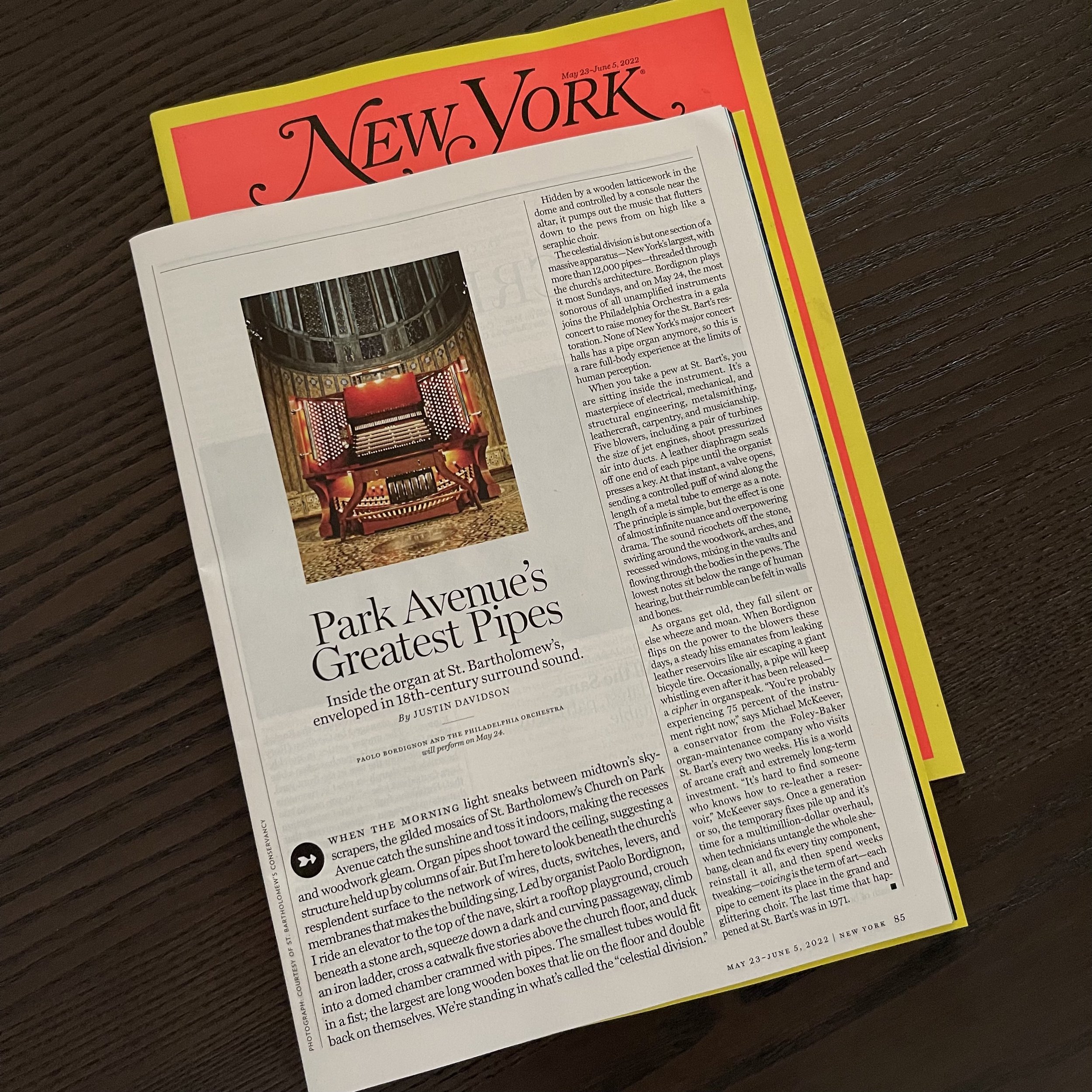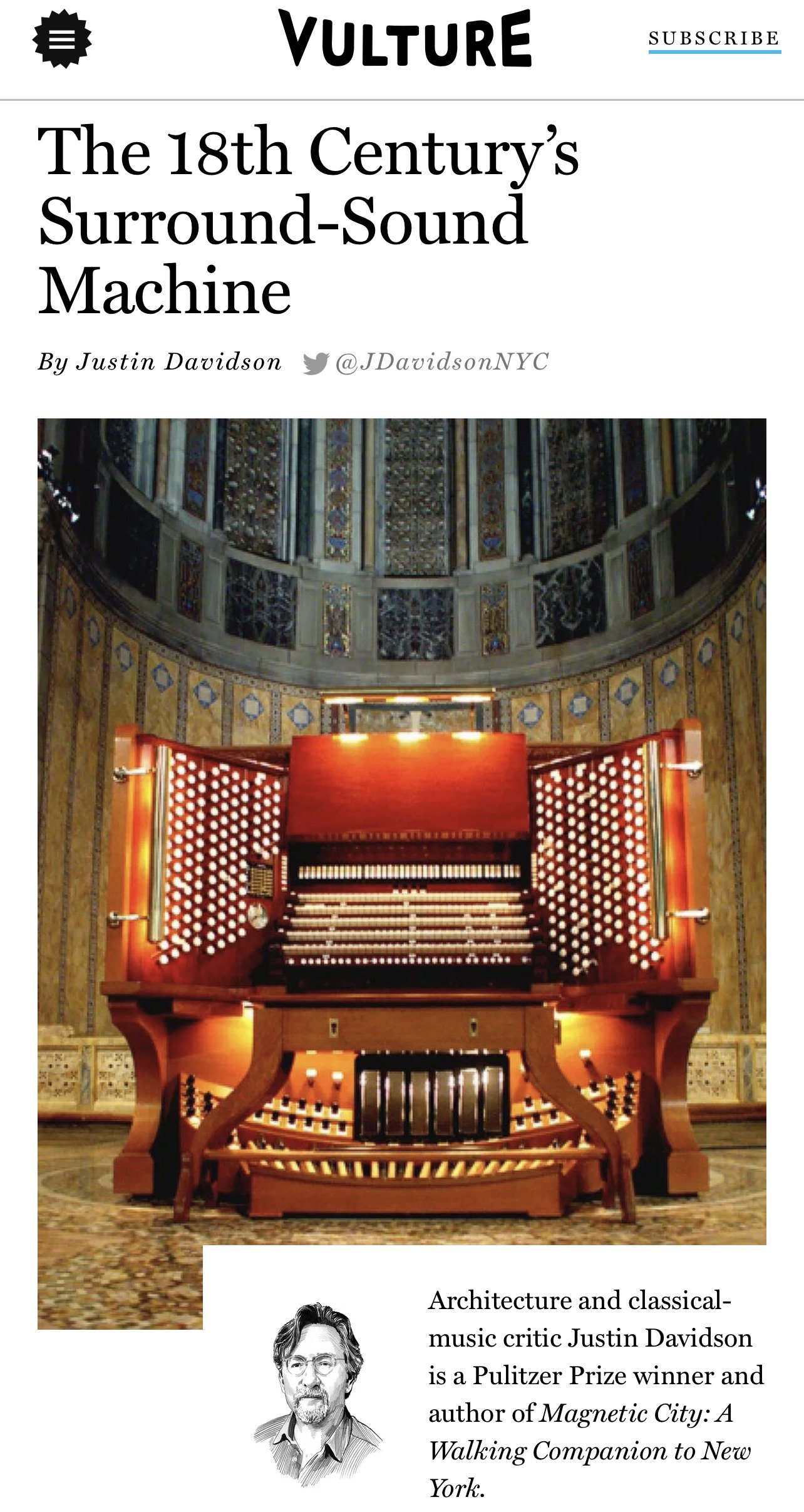Good Day NEW YORK
December 28, 2022
IDAGIO Interview
with Fred Plotkin
Paolo Bordignon appeared on IDAGIO’s Fred Plotkin on Fridays on December 23, 2022.
new york magazine
vulture.com
Feature by Justin Davidson
"The celestial division is just one section of a massive apparatus — New York’s largest, with more than 12,000 pipes — threaded through the church’s architecture. Bordignon plays it most Sundays, but on May 24, the most sonorous of all unamplified instruments joins The Philadelphia Orchestra in a gala concert to raise money for the church’s restoration."
Wall Street Journal
‘Amy Beach: American Romantic’ Review:
Combing the Beach of Classical Music
A PBS documentary explores the life and career of Amy Beach, the first prominent American female composer of orchestral music.
“Where ‘Amy Beach’ finally arrives is at the American composer’s natural affinity for Romanticism and at St. Bartholomew’s Church in New York, where Beach became a parishioner following a sojourn in Europe and for which she wrote organ and choral music. The performances of both at the Park Avenue church are among the highlights of the show.“
the boston globe
Review: Boston Symphony Chamber Players
“Listening to Bordignon locking together with flutist Elizabeth Rowe, oboist John Ferrillo, and cellist Blaise Déjardin in the devilish Carter sonata at the end of the first half, one would never know he didn’t play with the Chamber Players crew every week. Here the harpsichord intoned a steady pulse; here it spun up into a thorny perpetual motion machine, while Rowe and Ferrillo traded blunt incantations with such clarity that the two instruments were often indistinguishable from each other.”
“Manuel de Falla’s radiant Concerto for harpsichord, flute, oboe, clarinet, violin and cello ended the concert with a carnival of sound. The outer movements of the busy piece recalled memories of bustling crowds, flashing lights, and the smell of excitement.”
The Boston Musical Intelligencer
Review of Boston Symphony Chamber Players in repertoire including Manuel de Falla’s Concerto for harpsichord, flute, oboe, clarinet, violin, and cello; and Elliott Carter’s Sonata for flute, oboe, cello, and harpsichord.
Read story here
"carefully sculpted & considered, yet utterly spontaneous"
"Compelling"
"One of the show-stopping moments of the afternoon was Bordignon’s brilliant riffing of the long cadenza in Brandenburg No.5 with its spinning figures that can sound at moments like the revolving riffs of a rock guitar."
"Bordignon’s performance was a quiet marvel of concentration"
"Supreme technical wizardry"
"At the risk of singling out one player among the superb cast — forgive me, I am a keyboard player — I must say that Mr. Bordignon’s harpsichord playing was outstanding and engaging throughout. [...] The elaborate cadenza at the end of the first movement (which is treacherous for the player) was an absolute tour de force. I looked up to the balcony and saw some faces completely rapt. Mine was smiling."
"He showed obvious affinity for the French music of Rameau in two Pièces de Clavecin, giving a more finely shaded performance that one would think possible"
"mastery of the instrument"
"evoked all the charm of a bygone era"
"a thunderous interpretation"
"The audience response was so strong that after the second piece there were two bows, and there were whoas, wows, and a standing ovation before the intermission."
New York Times
Elliott Carter: Double Concerto for Harpsichord and Piano and Two Chamber Orchestras
"The music was well served by this compelling performance."
"pulling back the orchestra to allow the continuo harpsichord (played by Paolo Bordignon) to shine during a repeated section of the Andante was an unusual but inspired touch."
New York Times
Mozart: Symphony No. 1
"outstanding... lively... distinctive... a thunderous interpretation."
New York Sun
Bach: Prelude & Fugue in C Minor for organ, BWV 546
New personnel to Camerata [Pacifica’s All-Brandenburg 25th Anniversary Season Closer] included world-class organist/harpsichordist Paolo Bordignon. Harpsichord plays a central role in the Brandenburgs, not only tonally but also rhythmically, with its silvery-edged attack. One of the show-stopping moments of the afternoon was Bordignon’s brilliant riffing of the long cadenza in Brandenburg No.5 with its spinning figures that can sound at moments like the revolving riffs of a rock guitar.
Santa Barbara Independent
Bach: Brandenburg Concerti
Crescenta Valley Weekly
Bach: Goldberg Variations
Transcendence was on display, both in performance and in score, on Saturday afternoon at the Huntington Gardens [Pasadena, CA]. Paolo Bordignon, under the auspices of Camerata Pacifica, performed J. S. Bach’s “Goldberg Variations" on a reproduction of a period harpsichord.
Whereas biography is sometimes inextricable from a composer’s work – think of Beethoven, Schumann, Mahler, or Shostakovich – Bach’s music stands apart from the life of the man. Joy and sorrow tint his scores without ever overwhelming the structure. It is music that encompasses emotion without ever becoming about it.
Bordignon’s performance was a quiet marvel of concentration that allowed the listener to relish the details of each variation without sacrificing architectural control. The result was of a kaleidoscopic mosaic, with each variation a dazzling piece that tells on its own as well as part of a whole. Everything was carefully sculpted and considered, yet sounded utterly spontaneous.
Paolo Bordignon, on harpsichord, contributed reliable continuo throughout the evening and played his solo passages with magical dexterity. He showed obvious affinity for the French music of Rameau in two Pièces de Clavecin, giving a more finely shaded performance that one would think possible, given the mechanics of tone production on the harpsichord.
Rameau’s miniatures are a cornucopia of musical invention and Bordignon played the highly ornamented works with charm and delicacy where warranted and with supreme technical wizardry where demanded.
Deseret News
Rameau: Pièces de Clavecin
Canadian-born harpsichordist Paolo Bordignon entertained the capacity crowd with “Fanfarinette" and “Gavotte avec six doubles" from “Pièces de clavecin" by Rameau. This talented keyboardist evoked all the charm of a bygone era. Bordignon’s stylings were right on the mark as he amply showed us his fluid technique and mastery of the instrument.
Salt Lake Tribune
Rameau: Pièces de Clavecin
Heaven knows it would have been fascinating to hear a performance of the full mass that Joseph Rheinberger composed when he was only 7 years old, but for Sunday's installment of the Summer Festival of Sacred Music, the associate director of music at St. Bartholomew's Church, Paolo Bordignon, prudently programmed a more mature work, the Cantus Missae, Opus 109.
The singing of the Cantus Missae was quite special, a great deal of power emanating from the Gloria and its ending Sancto Spiritu fugue. Especially ear-catching was the beginning of the Sanctus, a celestial mingling of the highest of voices in the finest tradition of Monteverdi. […] For sheer beauty of sound, Rheinberger is hard to beat and for his realization, St. Bart's is difficult to surpass.
New York Sun
Rheingerber: Cantus Missae, Op. 109
On Aug. 1 at the Bridgehampton Presbyterian Church there was an evening of Music Richly Ringing, a phrase taken from a Dresden newspaper that said in 1731, “When our own Bach’s music richly rings, he puts great Orpheus himself to shame."
For the first time in its 27 seasons the festival had an all-Bach program, and the concert was sold out days ahead. The audience response was so strong that after the second piece there were two bows, and there were whoas, wows, and a standing ovation before the intermission.
The festival usually brings together a variety of musicians with impeccable credentials to perform in a given concert. Many of the performers may be returning to the festival and may have played together before, but do not play together regularly in an established group. The excitement and verve that these players bring to being together for a short time has always been outstanding.
From the beginning of the Concerto for Flute, Violin, and Harpsichord in A minor, the ensemble was tight and vibrant, and the sound was glorious in the acoustics of the church. The soloists were Marya Martin, founder and artistic director of the festival, on flute, Jesse Mills, violin, and Paolo Bordignon, harpsichord, with the ensemble played by Jessica Lee, violin, Karen Gomyo, violin, Choon-Jin Chang, viola, Christian Poltera, cello, and Jeffrey Beecher, double bass.
Randall Scarlata was the fine baritone for the sacred aria “Doch Weichet, Ihr Tollen, Vergeblichen Sorgen," which is musically picturesque as “you senseless, useless worries" are chased and scurry away, until peace is finally reached in the hereafter. The intricate interplay between Mr. Scarlata’s voice and Ms. Martin’s flute a couple of octaves higher were carried off with aplomb. (And the applause demanded a second bow.)
For the Concerto for Two Violins in D minor, Ani Kavafian joined with Ms. Gomyo for the solos. The opening Vivace has a jaunty theme that somehow seems brighter than a minor key, the middle Largo was beautifully touching, and the Allegro just soared with vitality. (And brought a standing ovation midway through the program.)
A smaller group of just four instruments and baritone gave a nice change of texture in the aria “Ja, Ja, Ich Halte Jesum Feste," which Mr. Scarlata jokingly called “another joyous death aria." But it expressed the essence of Bach’s theology: not a lugubrious ending, but a confidence in the promised eternal life.
One of the best known of all of Bach’s melodies is from the aria “Schafe Koennen Sicher Weiden," or “Sheep May Safely Graze." It is from a secular cantata written for the birthday of Duke Christian of Weissenfels, and although it is often heard with a sacred translation, the “caring shepherd" and protector actually referred to is the duke, not a deity. The pastoral setting is portrayed by a happy duet with flute and violin, and longer-held notes in the voice.
What to top all of this with? The Brandenburg Concerto No. 5 in D, perhaps the most irrepressibly exuberant of Bach’s orchestral works; and that is how it was played.
At the risk of singling out one player among the superb cast — forgive me, I am a keyboard player — I must say that Mr. Bordignon’s harpsichord playing was outstanding and engaging throughout. One reason it stood out is because I don’t recall hearing a harpsichord at the festival recently. The elaborate cadenza at the end of the first movement (which is treacherous for the player) was an absolute tour de force. I looked up to the balcony and saw some faces completely rapt. Mine was smiling.
East Hampton Star
All-Bach program
An impressively diverse program on one of New York’s oldest functioning instruments. This time around the [Metropolitan Museum of Art] didn’t have a crew of volunteers manfully pumping the manual bellows, a telltale blower pipe trailing from the back of the cabinet to a rear storeroom. Noted New York organist Paolo Bordignon began his performance with a quaint couple of pieces, Giovanni Pescetti’s Sonata in C Minor for three movements and then Haydn’s Five Pieces for Musical Clocks, each a whimsical suite that served as a showcase for the organ’s flute registrations. Pachelbel’s Ciacona in D Minor brought some lower registrations to the continuing baroque mood. Then he brought in some artillery with three of the great French composer Louis Vierne’s 24 Pieces en Style Libre. The Preambule was a stark contrast, all airy, eerie ambience, followed by the gorgeously nocturnal Complainte and ending pretty much where he began with the Prelude. Finally, with a warmly robust take of Mendelssohn’s Prelude and Fugue in D Minor, he gave himself a chance to air out the organ and this proved very much worth the wait. This is obviously not an easy instrument to play, but Bordignon proved indomitable.
Lucid Culture:
NYC Concert Review
Organ Recital at the Metropolitan Museum of Art









